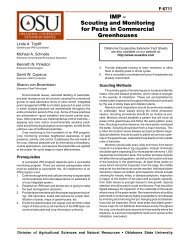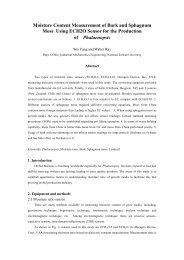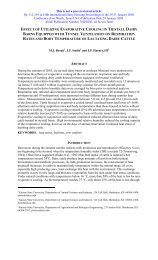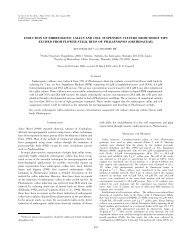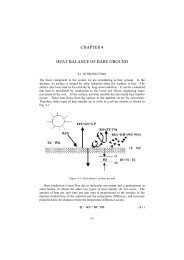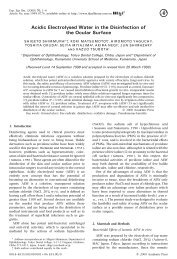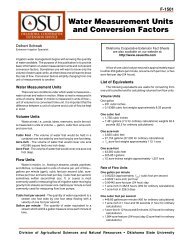ELECTRICAL SYSTEMS & THE GREENHOUSE
ELECTRICAL SYSTEMS & THE GREENHOUSE
ELECTRICAL SYSTEMS & THE GREENHOUSE
- No tags were found...
Create successful ePaper yourself
Turn your PDF publications into a flip-book with our unique Google optimized e-Paper software.
H E L P F U L H I N T S<strong>ELECTRICAL</strong><strong>SYSTEMS</strong> & <strong>THE</strong><strong>GREENHOUSE</strong>PUBLISHED BY:<strong>THE</strong> NATIONAL <strong>GREENHOUSE</strong>MANUFACTURERS ASSOCIATIONHow does electricity work?Electricity moves through wires, pushed along bya force called potential. Electric potential is measuredin units of volts. The voltage forcing electricitythrough the power wiring comes from a utilitycompany’s generating plant. Large wires areneeded to carry large currents. Electricity facesresistance to its flow through a wire, and in fact,resistance is the electrical term for the force thatworks against the free-flow of electricity.Resistance is measured in units called ohms.Electricity, voltage and current all work together toform power, which is measured by watts.What is voltage drop?In a greenhouse, equipment can easily be hundredsof feet from the circuit breaker panel thatfeeds it power. Wires have resistance and resistanceworks against voltage. This effect is calledvoltage drop and relates directly to the efficiencyof the equipment we connect with electricalwiring. Voltage drop also has another effect: thevoltage doesn’t just disappear, it gets convertedinto heat that is wasted, even though you pay forit on your utility bill.How do I eliminate voltage drop?While there’s no way to completely eliminatevoltage drops and other inefficiencies, you canminimize them by working with a design engineerwho is familiar with greenhouses. A design engineerwill provide an electrical system that meetsyour requirements for safety, efficiency, adequacy,convenience, and spare capacity. You’ll need tocoordinate both the design and installation phasesof your electrical system with your local electricutility as only they can tell you if they can providethe type of system you require with the capacityyou need.
What are the most importantthings to consider when creatingan electrical greenhouse system?Demand that all work be done in accordance withthe National Electric Code and local codes. Listall equipment requiring electricity. Have a designengineer prepare a load schedule, main service andbranch layout, power diagrams, wiring layout, andcontrol diagrams.What is a load schedule?This is an inventory of all the electrical equipmentin your project. The total electrical demand of thisequipment determines the size of electrical serviceyou’ll require.What is the main service andbranch panel board layout?This shows the location and size of your serviceentrance components and any additional circuitbreaker panels you will need. The serviceentrance is where the wires from the electric utilityenter your property and include a large switch orcircuit breaker that can disconnect your entirepremises from the electrical grid.What are one-line power diagrams?These diagrams show how your equipment willbe assigned to individual circuit breakers andbreaker panels. These plans show the numberand the sizes of the wires that will carry power toyour equipment.What is a conduit andwiring layout?This diagram shows where conduits will be routed,the sizes of the conduits, and the number and sizesof the wires that will be run into the conduit.What are control diagramsand schematics?These plans show the interface between controldevices and the equipment they control.Where should I locate mymain service?The location of your main service entrance mustbe coordinated with your electric utility. A centrallocation minimizes wire lengths and reduces boththe costs of voltage drop and of the wire itself. Acentrally located main service is your most efficientand economical alternative.What type of power systemshould I purchase?One-phase systems are commonly used in housesand small businesses. Three phase systems areused in schools, medium to large businesses, andindustrial plants. Though three-phase power is notavailable everywhere there are technical advantagesthat should be considered. Do not be afraidto go for high voltage. The higher voltages meanthe voltage drops are less significant. Becausepower is the product of volts and amps, a highervoltage means we can deliver the same total powerwhile using fewer amps. The practical benefit ofreduced amperage is reduced wire size.What are the advantages to threephasepower?Three-phase motors are less expensive thansingle-phase motors for motors of one horsepoweror larger. Also, they are mechanically andelectrically simpler than single-phase motors. Athree-phase system can use smaller wires andconduits than a single-phase system — and aremore reliable.
Do I need a standby generator?Because a greenhouse can lose and gain heat sorapidly, it is critically dependent on a constantsupply of power for its heating and coolingsystems. Because a power outage of more than afew minutes can mean the loss of your livelihood,you must consider a standby generator when youplan your electrical system.What is an automatictransfer system?Automatic transfer systems are available whichstart the generator, allow the engine to warm upand the generator to come to full power, and thenconnect the generator to your greenhouse equipment.When utility power returns, these systemsreverse the process, and shut down the generator.How do voltage drops affectcrop lighting?Voltage drops have a disproportionate affect on thelight output of incandescent lamps. If the electricalsystem delivers a voltage below the rated operatingvoltage of the lamps, they cannot deliver theintended amount of light. The light loss can be significantand is often undetectable to the human eye.What are the benefits ofhigh-efficiency motors?Though high-efficiency motors cost more thanstandard motors, the energy savings they offereasily outweigh the cost difference. A one-horsepower, high-efficiency motor can pay for the costdifference in only four months of typical greenhouseuse. A high-efficiency motor is built usingmore copper wire and iron than a standard motorand it runs cooler than a standard motor.What is a ground-faultcircuit interrupter?A ground-fault circuit interrupter, or GFCI, is asafety device that protects people from possibleelectric shock hazards. A typical GFCI is builtinto an electrical outlet to kill the power once anelectrical fault is detected. The National ElectricalCode (NEC), which regulates electrical wiring, hasbegun to require ground-fault circuit interrupters inmore and more locations; particularly in damplocations in contact with the earth or concrete.Where can I attain moreinformation regardingelectrical standards?The NGMA has published an electrical guidelinewhich you can receive for free by contacting theNGMA office or download it off the web:www.NGMA.comVISIT US ON <strong>THE</strong> WEB:www.NGMA.com20 W. Dry Creek Circle, Suite 110Littleton, CO 80120800-792-NGMA (6462)303-798-1338 • FAX 303-798-1315



